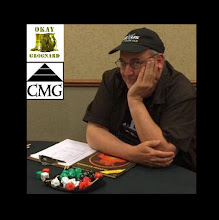In the first column by Monte Cook as he returned to the fold with WotC, he takes a look at Perception. He's on the right track, it seems, though the one sentence that I think bothers me is, "And it would be horrible if a poor die roll wrecked it all." If something needs to be found for everything to work, then either it isn't hidden or, at least, there is no roll to be made. In some instances, it is a mistake to design oneself into a corner that requires some element within an adventure to both be hidden and also be found. However, there is a school of thought that leads to adventure design as plot-driven or story-driven in such a way as to wind up in that corner on a regular basis. I'll discuss character driven versus story-driven gaming another time, though, so let's look at this problem from the design perspective of balance.
Now in an old school situation, adventurers might go back and forth to a dungeon and even particular areas of a dungeon time and time again. Things that aren't found early on can often be found on subsequent treks. New school thinking has smaller venues, generally, and they become disposable in a manner of speaking. An adventure location is often used just once and then the game/campaign moves on to other locations. Sure, sometimes a home base is used repeatedly, such as a city or town, but for the most part an adventure is run and then becomes campaign history.
This plays into the mindset of the business model that a large company or corporation simply needs to follow to exist. New products must be produced on a regular basis. For a group to enjoy one and then move on and buy another, the experience with each needs to be satisfying, things need to be found. In this model, hidden doors and treasures cannot go unfound, again, generally speaking, because there is not likely to be a future trek in the same place to have more chances to find those hidden things that were missed.
Because of this, if an adventure or campaign is story-driven and requires that certain elements need to be found, then there needs to be a classification of "faux-hidden." If design of an adventure is going to hinge on one or two elements being discovered, those elements simply need to be written up as key elements that the GM needs to be advised are "crucial." There's no need for there to be discussion of how one poor die roll can ruin the story because the designer must dictate that those crucial elements do not remain hidden. Some might cry, "Railroad!" at this, but story-driven adventures are always going to have railroady aspects to them. They don't develop organically through character so there is no way around it.
However, as I mentioned at the top, this also brings up the topic of balance. Once we begin to discuss crucial and non-crucial elements we also need to have the discussion about system balance and how it relates to the relative experiences of two game groups using the same materials. If there are multiple hidden doors or treasures (assuming the treasures are hidden on their own or beyond those hidden doors), how can any adventure run for two separate groups ensure that both groups will come out the other side with approximately the same experience and wealth? How can a two GMs be sure that if they run the same adventure one group won't find all of the goodies while the other group comes away scratching their heads over the total lack of treasure found?
In old school systems, balance issues were largely ignored. Sure, you had levels or some type of advancement but purchased adventures were often scaled in such a way that groups of characters could consist of, sometimes, markedly different levels (generically speaking) of power from one character to another. In many (most?) new school systems, balance seems vital to the enjoyment of the game such that some players will complain if they notice one character seeming to pull ahead of others in power, abilities, or wealth.
So, can a system be devised that manages to maintain some level of balance without being broken if balance between characters isn't perfect? Can the idea of balance be downplayed, not so essential (small "e") that it requires homogenization of elements within the game to the point that the flavor of a system comes off as not much more than a veneer? These questions have come up repeatedly as I have worked on Griffins & Grottos Wargame and Roleplaying System (to be released in late October 2011). In future blogs I’ll discuss some of the ways I have tried to make the system less of a slave to balance even as I attempted to include a variety of ways in which balance is seamlessly inherent. Sign up to follow this blog and I'll try to keep you interested as I write more on this and other subjects.
Subscribe to:
Post Comments (Atom)



No comments:
Post a Comment